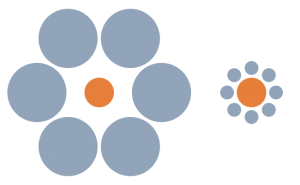To Review: why do we have multiple interpretations of physical world?
As pointed out in Genna’s blog, 3D objects in the real world are represented in 2D format on our retina. Our visual system, then, has to take this 2D signal and build back out of the 3D object that caused it. This is a difficult problem because lots of different 3D objects can produce the exact same 3D projection, which is analogical to the inverse problem in math. In some unfortunate cases, you can have multiple solutions or interpretation given one set of data or representation.
Context effects or subjective constancy
1. The ultimate purpose for our brain is not to exactly record every piece of information in the physical world around us, which is also impossible given our limited brain capacity, but to recognize and/or manipulate the relevant object we really care about. Thus, we have to consider the contextual factors such as the strength of light etc to get a coherent idea of the same object under different circumstances.
1.1 For example, the brightness constancy: When you read printed text on a page under indoor lighting, the amount of light reflected by the white space on the page is lower than the amount of light that would be reflected by the black letters in direct sunlight. Your brain doesn’t really care about actual light levels, though, and instead interprets the letters as black because they remain darker than the rest of the page, no matter the lighting conditions. In other words, every newspaper is also a visual illusion!
1.2 Similar benefit for color constancy: We only obtain color constancy when we consider the contextual factors. In this way, under varying illumination conditions, our perceived color of objects remains relatively constant or coherent. A green apple, for instance, looks green to us both at midday when the main illumination is white sunlight, and at sunset when the main illumination is red. Otherwise, a white paper will looks greenish in red light but reddish in green light, which is pretty annoying and confusing and will not help us to identify and manipulate specific objects to serve them for our lives. 
1.3 Get a sense of this phenomena in the following illusion (Edward Adelson at MIT) in which squares A and B are the same shade of gray (If you don’t believe it, print it out and then cut out the two squares and place them side by side.) It is simply that the gray square looks lighter when surrounded by black than when it is surrounded by white:
2. ‘Backfire’ effects: The context effects were originally supposed to be implemented in our brain to obtain object constancy or coherency; however, it overdoes its job occasionally. When the same image is surrounded by different contextual information simultaneously (artificially made), our brain will automatically and inviolately start the ‘taking context into account’ procedure even when it is inappropriate. Most people perceive the central circle surrounded by large circles appears smaller than the central circle surrounded by small circles, an effect known as the Ebbinghaus illusion.
2.1 Weird but no damage: Actually it is not drastically  sad that we perceive wrongly under this condition because this illusion is intentionally made by sharp and intelligent vision scientists and is much rarer in real life than natural images. Fortunately, in the majority of cases, we can still believe in our eyes. (Aha, sigh of relief!)
sad that we perceive wrongly under this condition because this illusion is intentionally made by sharp and intelligent vision scientists and is much rarer in real life than natural images. Fortunately, in the majority of cases, we can still believe in our eyes. (Aha, sigh of relief!)
2.2 Relation with brain size: Recently, Samuel Schwarzkopf and colleagues at University College London scanned each volunteer’s brain using fMRI while they were shown this illusion. They found that people with a smaller visual cortex experienced the Ebbinghaus illusion more strongly. Schwarzkopf suggests that this is because the circuits in the visual cortex responsible for the illusion are the same size in everyone, but cover a greater proportion of a smaller visual cortex, causing a stronger effect. The team also found that people with a smaller visual cortex tended to have bigger brains overall, though it is not clear why. Wanna test you own brain size using visual illusion as a tool? Mmmm, not bad idea!
3. Artists’ Favor: Visual illusion is also gorgeous when being used as a technique by highly skilled and creative artists. They realize that they don’t need huge 3-dimentiona space to construct a visual satisfying virtual world because our visual system can be easily cheated according to certain rules and principles. It is called 3-D illusions on flat surface only using the Pictorial cues such as perspective and relative size to demonstrate magic visual effects.
3.1 Early time: As early as 17thcentry, the cupola of the St. Ignatius’s church in Rome is a great example of Baroque illusionism. The architect of the church, Horace Grassi, had originally planned to build a cupola, but died before finishing the church, and the money was used for something else. Thirty years later, in 1685, the Jesuit artist Andrea Pozzo (1642-1709) was asked to paint a fake dome on the ceiling over the altar. Pozzo was already considered a master in the art of perspective, but even then, the results he accomplished could hardly be believed. Even today, many visitors of St. Ignatius’s are amazed to find out that the spectacular cupola is not real, but an illusion.
3.2 Modern days: Artists like to do 3D Side Walk Illusions. Youmay have a look at the “Top 10: Awesome 3D Side Walk Illusions” website to enjoy the unbelievable visual effects of side walk drawing. I will just paste my favorite “Julian Beever‘s batman” here (ranked no. 5) since it is the most scary and breathtaking one for me.

